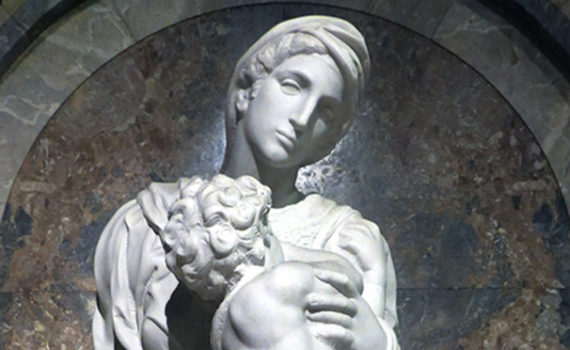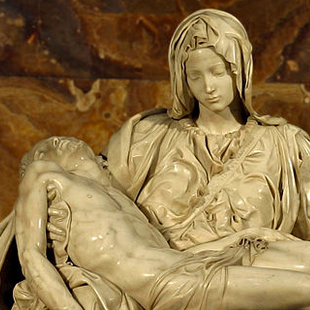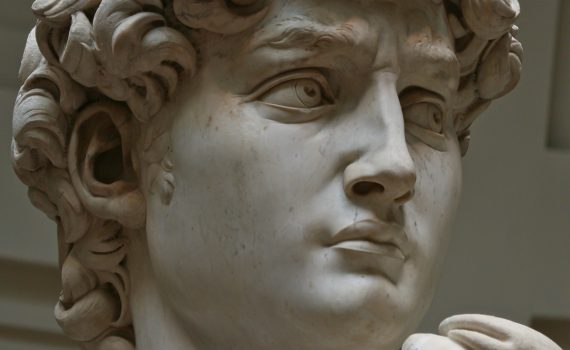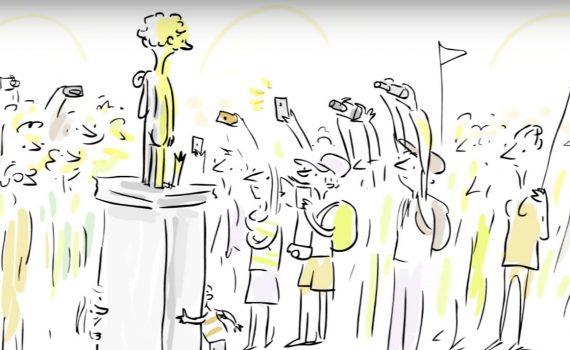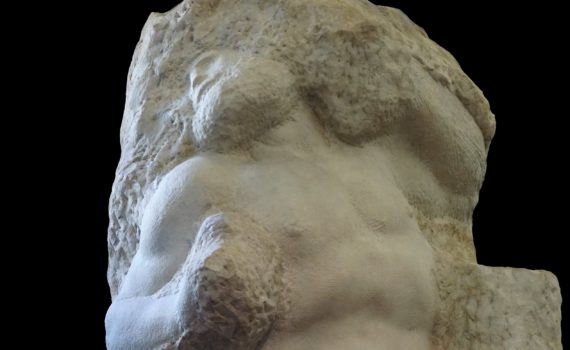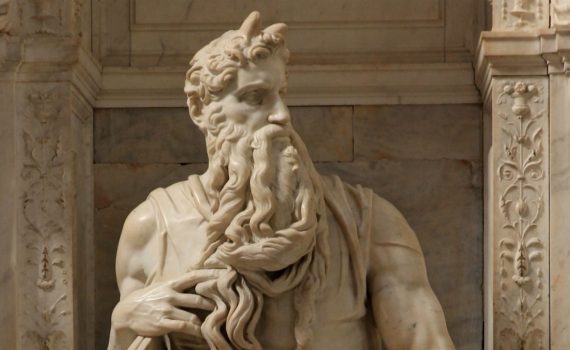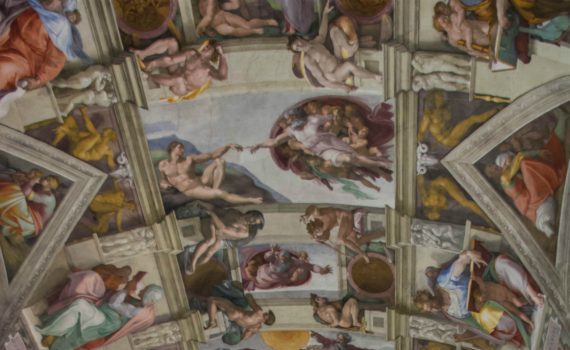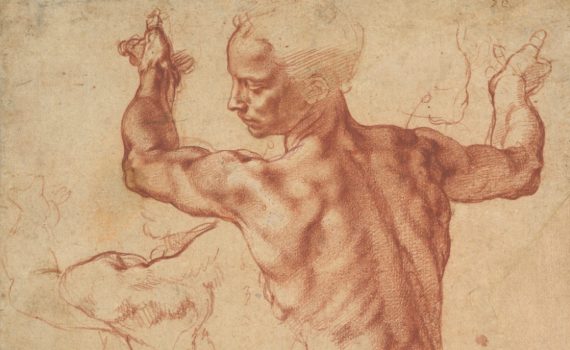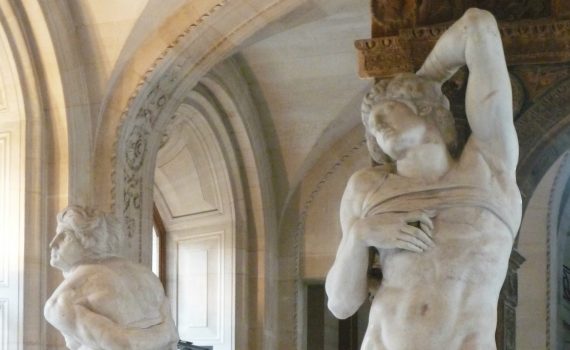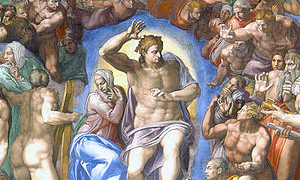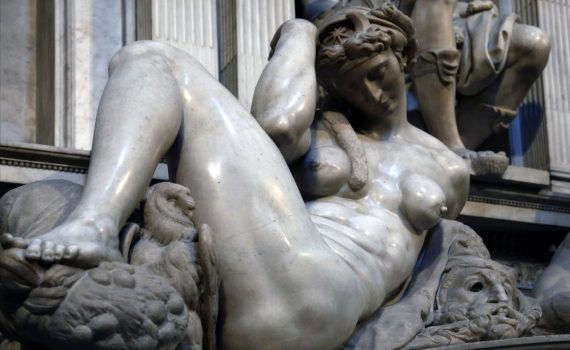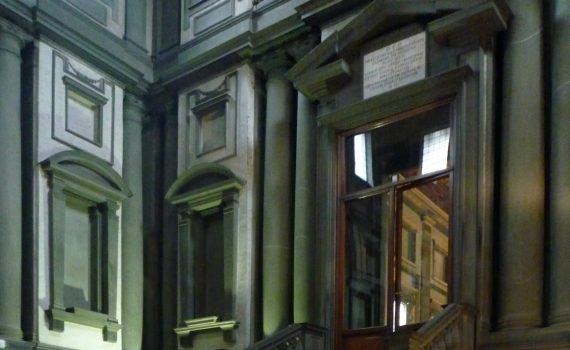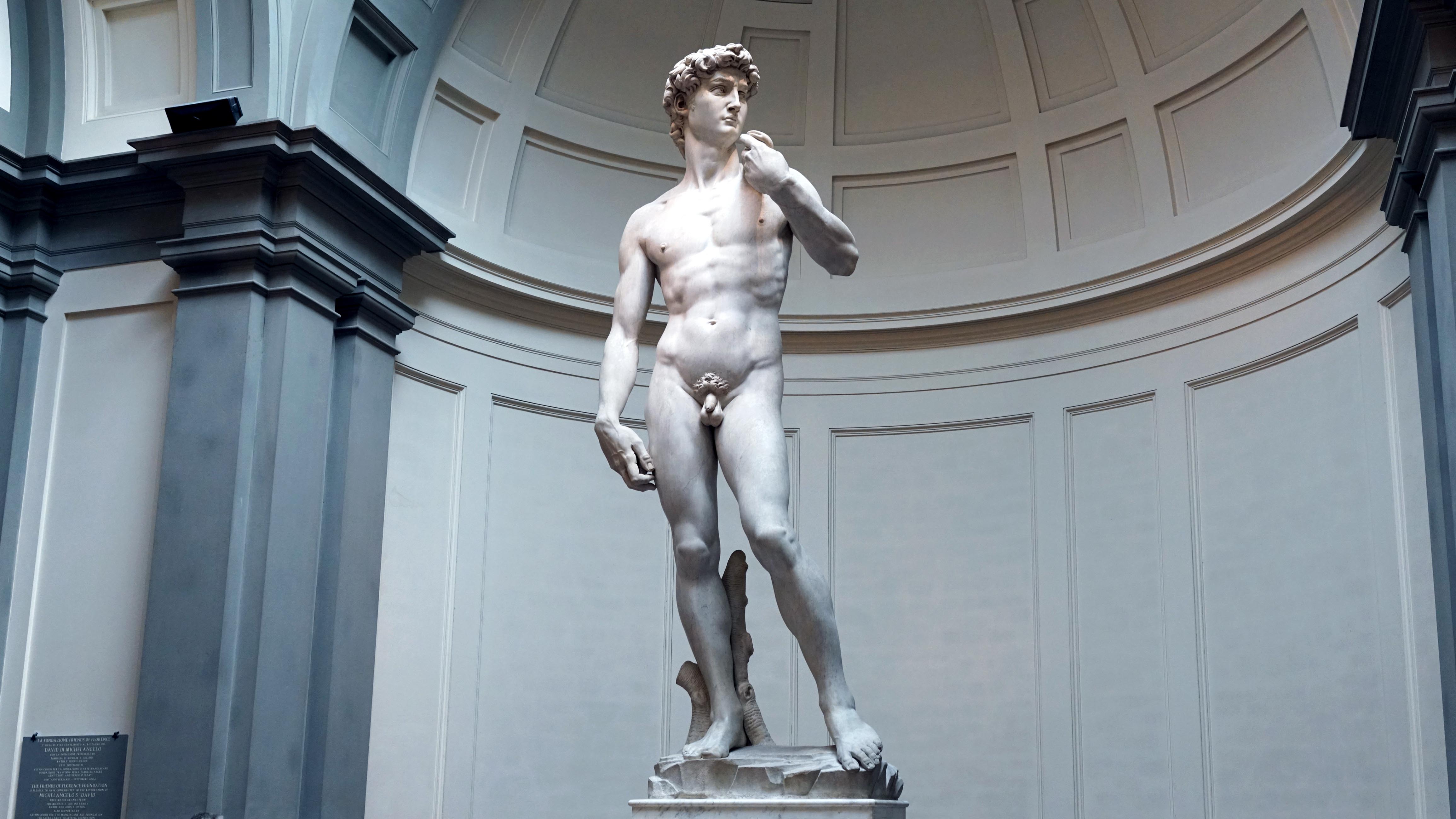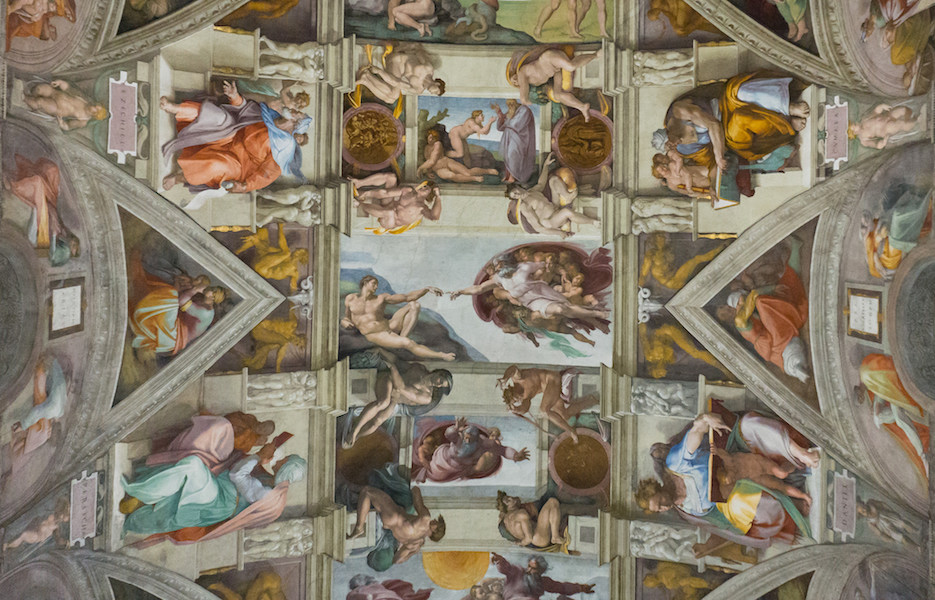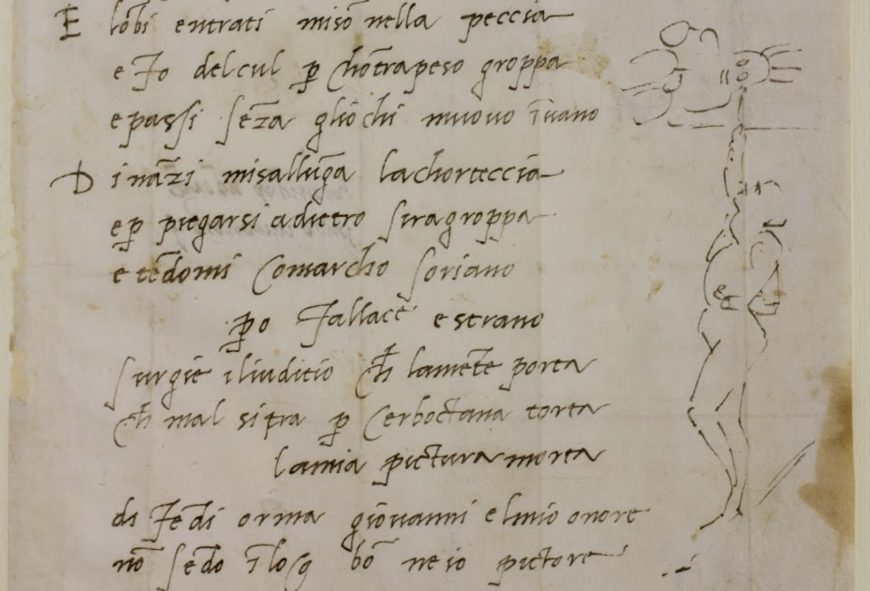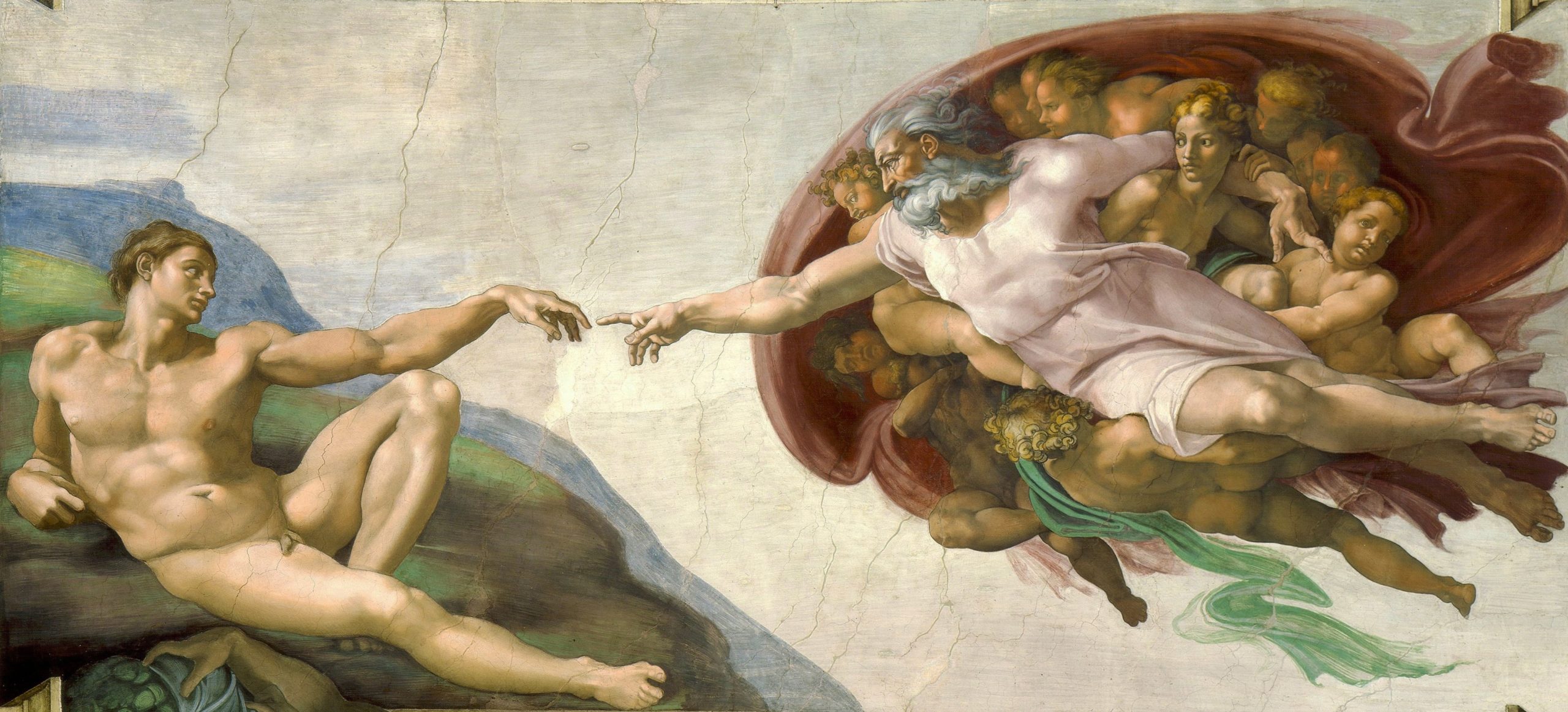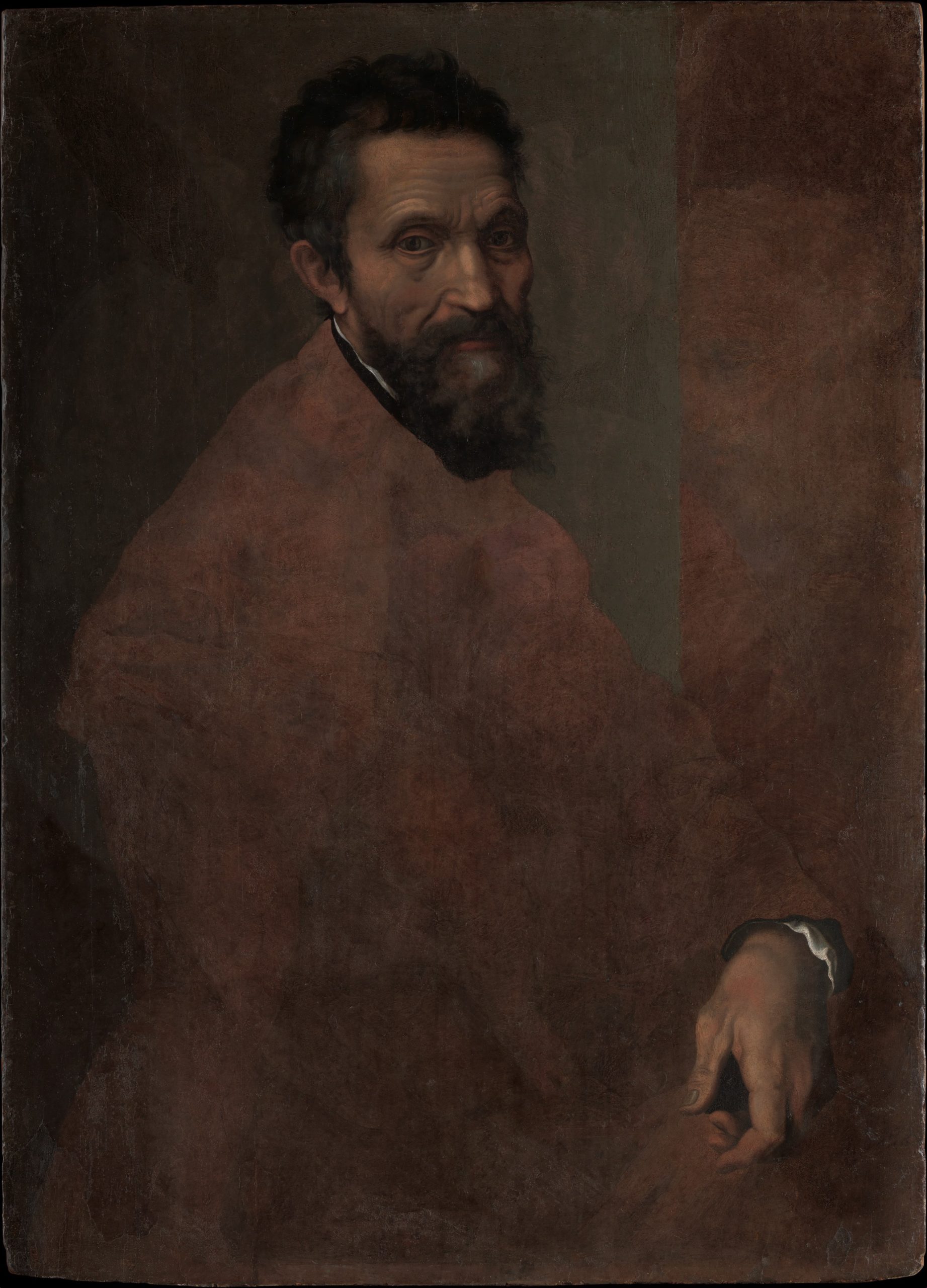
Attributed to Daniele da Volterra, Michelangelo Buonarroti, c. 1545, oil on wood, 88.3 x 64.1 cm (The Metropolitan Museum of Art)
“Who was Michelangelo?”
Essay by Dr. Tamara Smithers
Michelangelo Buonarotti—the Italian Renaissance painter, sculptor, architect, and poet—was called “Il Divino” (The Divine One) by his contemporaries because they perceived his artworks to be otherworldly. His art was in high demand, and thought to have terribilità, poorly translated as “terribleness” and better described as powerfulness. He was mythologized by followers, emulated by artists, celebrated by humanists, and patronized by a total of nine popes. As commemorations, over one hundred portraits of him were created during the sixteenth century alone, far more than any other artist at the time. Despite three biographies written about the artist during his own lifetime, we know the most about the sometimes-generous and often-humorous perfectionist through his letters. Not only do we have more primary sources on Michelangelo than any other historical artist, he is one of the most written-about artists of all time. In today’s terms, Michelangelo was a workaholic homebody whose cats missed him when he was away. He did not like to debate art, waste time, or show his work before he was ready. Despite a few mid-career collaborations, Michelangelo was careful and guarded, never running a typical workshop, locking his studio, and burning drawings. He also complained a lot, and, at times, could be overconfident, curt, and blunt, once resulting in a punch in the nose.
Better late than never
Although he became an artistic superstar, Michelangelo’s start was different from most artists of his time. His initial success can be credited to his family’s connections to the powerful, noble Florentine family, the Medici. In the early 1490s, he learned carving under the tutelage of a student of Donatello, Bertoldo di Giovanni, at the Medici sculpture garden. Upon entering the workshop of the painter Domenico Ghirlandaio, Michelangelo began his official professional training at the age of thirteen, several years later than usual (and unlike typical apprentices who had to pay to study under a master, Michelangelo was paid, perhaps due to his family’s relations to the Medici or his innate talent). However, he desired to sculpt instead, stating that he drank in his love of stone carving from his wet nurse, who came from a family of simple pastoral stonecutters.[1] To emphasize this aspect of himself for the first few decades of his career, he signed his letters “Michelangelo Sculptor.” Also important to his formative years was the dissection of cadavers to learn anatomy. The challenging conditions—after hours by candlelight and without refrigeration—called to only the most dedicated artists.
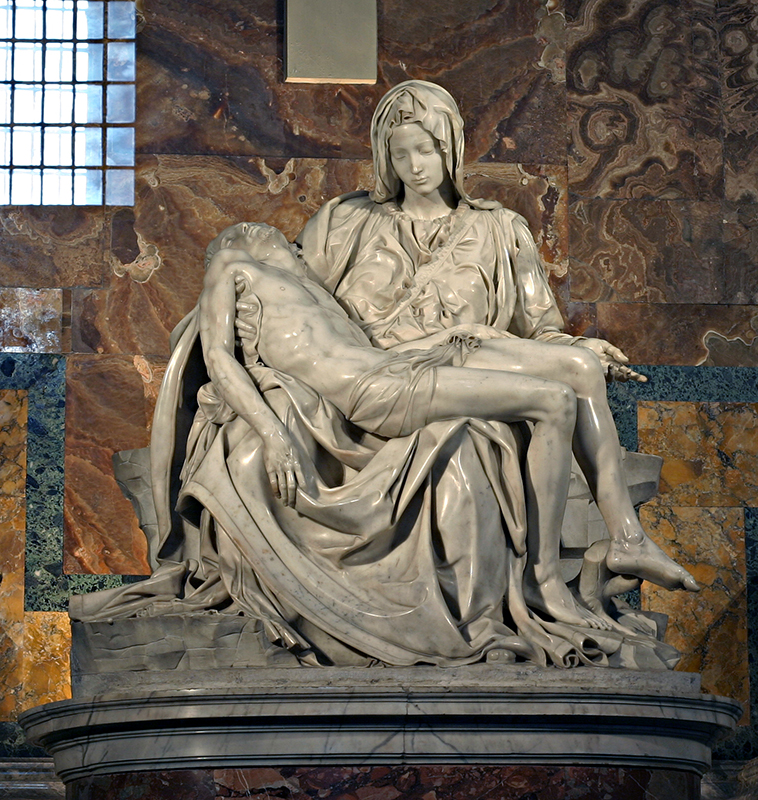
Michelangelo, Pietà, marble, 1498–1500 (Saint Peter’s Basilica, Rome. Photo: Stanislav Traykov, CC BY 2.5)
At twenty-three years old, Michelangelo accepted his first large-scale public project: to carve two full-scale figures within one piece of stone, a very difficult task. St. Peter’s Pietà, commissioned for the tomb of Cardinal Bilhères de Lagraulas, initiated his rise to fame. The pressure was on: the contract stated that the sculpture was to be the most beautiful work in Rome. After six months at the quarries to find the perfect marble, Michelangelo began carving the Pietà. When the sculpture was put on display in Old St. Peter’s Basilica (before the rebuilding initiated by Pope Julius II), pilgrims questioned who had made such a beautiful work. As the story goes, the sculptor overheard a group incorrectly attribute the work to another sculptor. Michelangelo snuck back in late that night with a lantern, hammer, and chisel to carve his name on the Virgin’s sash. It is the only work he ever signed, and he later regretted this act of excessive pride.
Already famous
Soon after, Michelangelo received an important commission in Florence. A figure of David was desired for up high on an outside buttress of the Duomo. He was tasked to re-use a nearly twenty-foot tall piece of marble nicknamed “The White Giant” that another artist had attempted but failed to carve forty years prior. Michelangelo stepped up to the challenge, completing the colossal statue in two years. In the end, the sculpture was placed outside the Palazzo Signoria.
The success of David led to a large-scale civic commission inside the palazzo to paint a battle scene for the Florentine government, the Battle of Cascina. This arrangement placed him in direct competition with Leonardo, who was already at work on the Battle of Anghiari on the opposite wall. While neither painting was ever finished, copies of both survive. Michelangelo’s cartoon (a full-scale preparatory drawing for the fresco), served as a sort of art school for younger artists who came to copy his figures. His drawings from this period are some of his most superbly rendered figures, with a distinct cross-hatching chiaroscuro technique. Disegno, or drawing, was considered both a manual pursuit and an intellectual endeavor and was the most important part of his practice. Sketching from the male nude was central to his art making.
In his next major fresco project, the ceiling of the Sistine Chapel commissioned by Pope Julius II, the main narrative represents nine stories of the Book of Genesis, such as the Creation of Adam. Michelangelo’s bulky, muscular figures were inspired by the ancient Laocoön, which he witnessed being unearthed in Rome in 1506. The study for the Libyan Sibyl is an exquisite preparatory drawing from this time, revealing his use of a male model for a female figure.
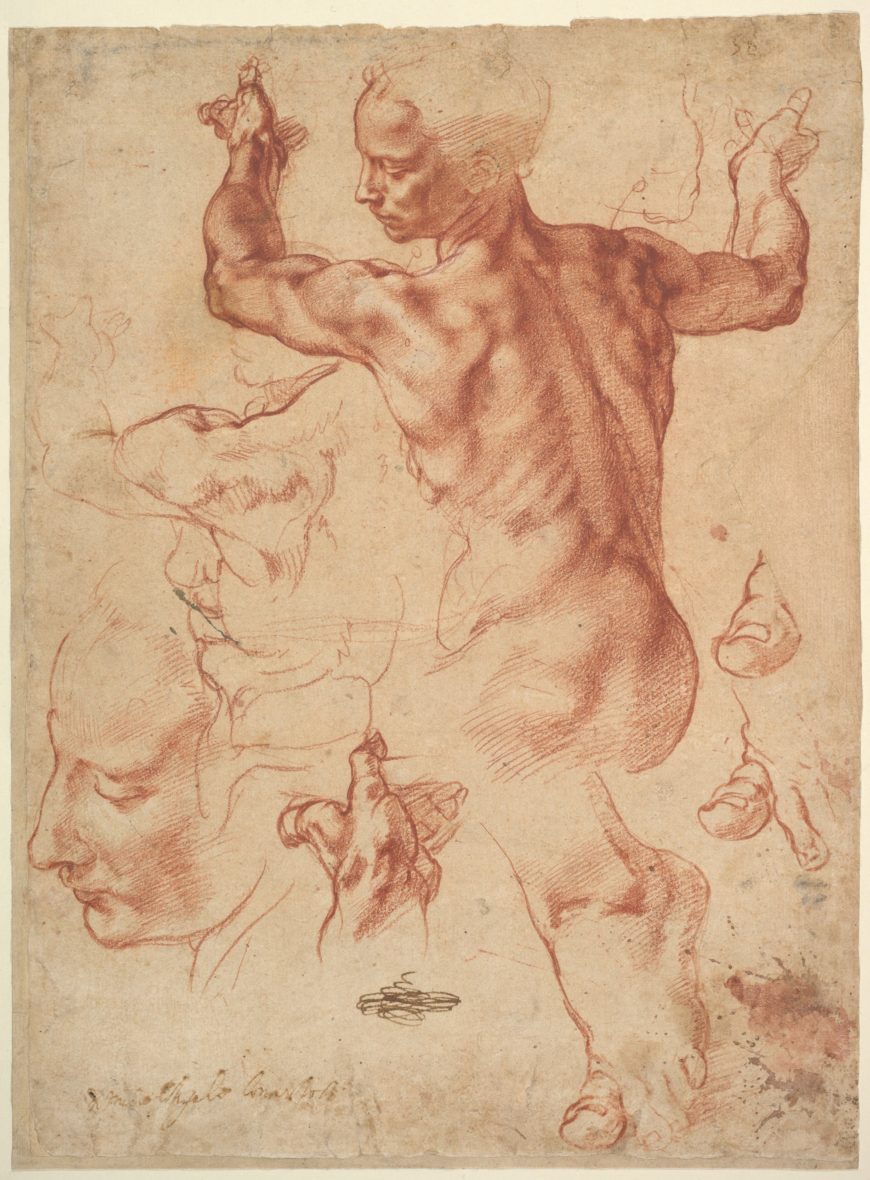
Michelangelo Buonarroti, Studies for the Libyan Sibyl (recto), c. 1510–11, red chalk, with small accents of white chalk on the left shoulder of the figure in the main study, 28.9 × 21.4 cm (The Metropolitan Museum of Art)
Michelangelo began painting the ceiling with the traditional method of using cartoons to transfer the design onto the wet plaster, but he became so proficient towards the end, he worked freehand. He also claimed to work without assistants (despite evidence otherwise), and preferred to keep his work private until finished. One story relays that he threw planks at Pope Julius II from the scaffolding, mistaking him for a spy![2]
The ceiling took Michelangelo over four years to paint. Initially, he did not want the commission, claiming that painting was not his art. He wrote a satirical poem about his personal struggle paired with a caricature of himself standing to paint: “With my beard towards heaven… I am bent like a Syrian bow….”[3]
Mid-Career but not middle of the pack
Michelangelo was initially called to Rome in 1505 to carve the tomb of Julius II intended for the center of New St. Peter’s Basilica, soon to be under construction. If fully realized, the monument would have contained over forty life-size figures, impossible for Michelangelo to ever have finished. The memorial was finally erected, in a reduced form in 1545, as a wall tomb in S. Pietro in Vincoli in Rome.
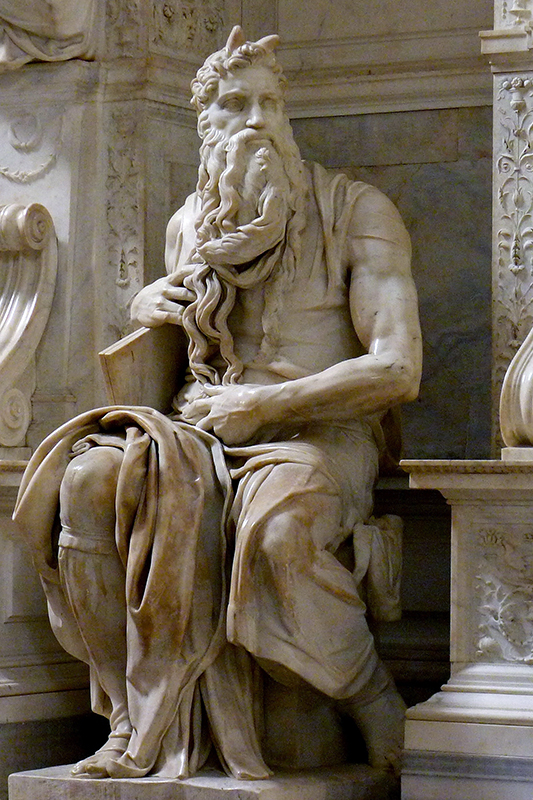
Michelangelo Buonarroti, Moses, 1513–15, Carrara marble, 254 cm (8 feet, 3 inches) high, Tomb of Pope Julius II (della Rovere), 1505–45, San Pietro in Vincoli, Rome (photo: Jörg Bittner Unna, CC BY 3.0)
The monumental Moses, intended for an upper corner, is now featured as the main figure. Two series of figures were never placed in the final arrangement: two bound “slaves” in the Louvre Museum in Paris and four struggling “captives” in the Accademia Museum in Florence. The Captives, likely carved in the 1520s, are bulky, block-like, and rough, where one can see the artist’s cross-hatching marks made with the gradina, a multi–toothed chisel. His preferred tool, the cane, a dog-toothed chisel, left distinct groove lines on the surface of the marble. Because of the roughness, these, and other sculptures, have been labeled non-finito, or unfinished, a topic much debated in scholarship.
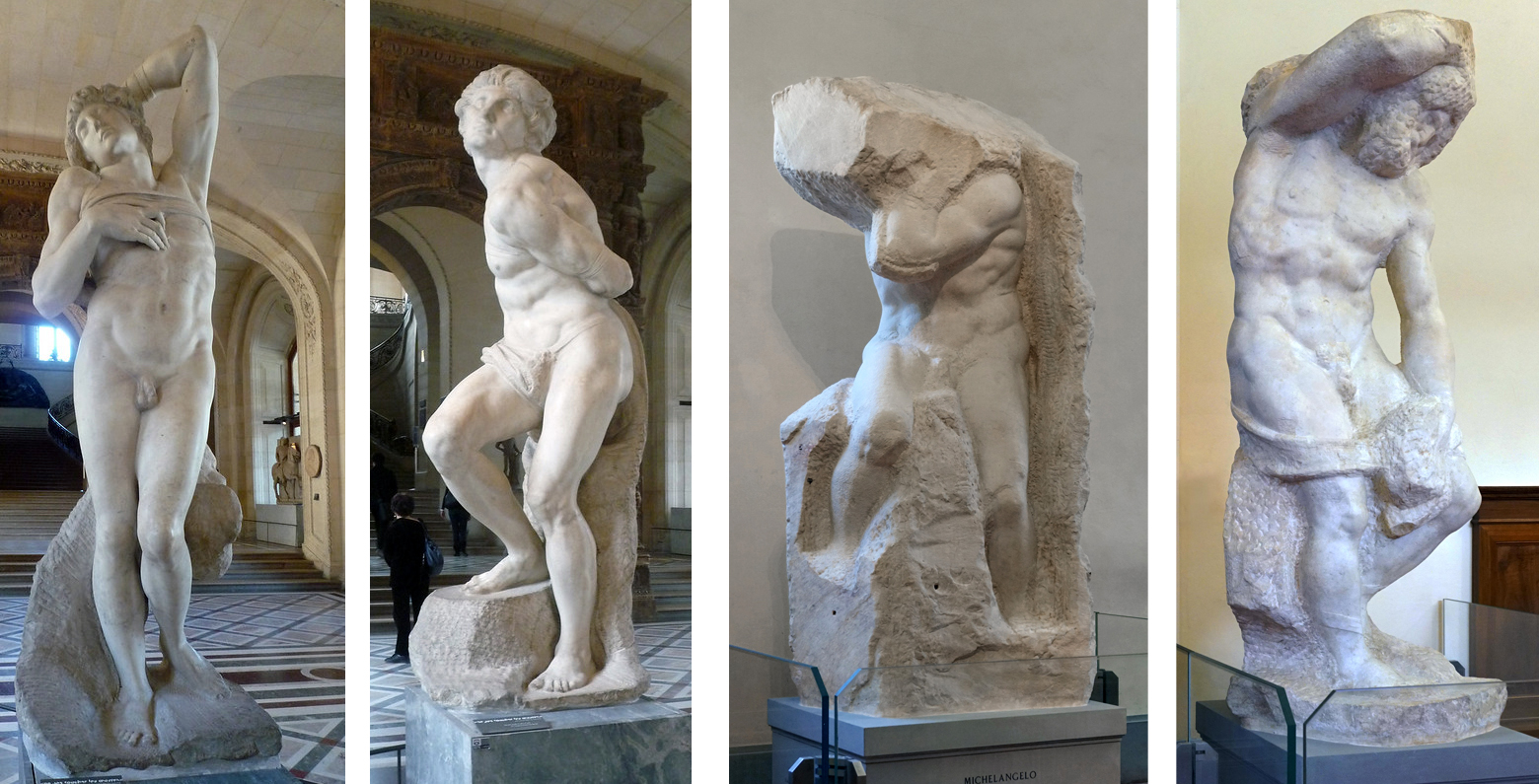
From left to right: Michelangelo, Slaves (commonly referred to as the Dying Slave and the Rebellious Slave), 1513–15, marble, 2.09 m high (Musée du Louvre, Paris, photo: Steven Zucker, CC BY-NC-SA 2.0); Captives (commonly referred to as the Atlas Captive and the Bearded Captive), c. 1530–34, marble, 2.77 m and 2.63 m high (Galleria dell’Accademia, Florence, photo: Steven Zucker, CC BY-NC-SA 2.0)
Michelangelo traveled back and forth from Rome and Florence during the late 1510s and 20s. In Florence, he worked for Julius’ successor, Pope Leo X de’ Medici, on the façade of the family’s church, San Lorenzo, which was never completed. It was here, though, where he honed his entrepreneurial skills, managing hundreds of workers under his direction. Michelangelo continued Medici employment under Pope Clement VII, designing the Laurentian Library and the New Sacristy.
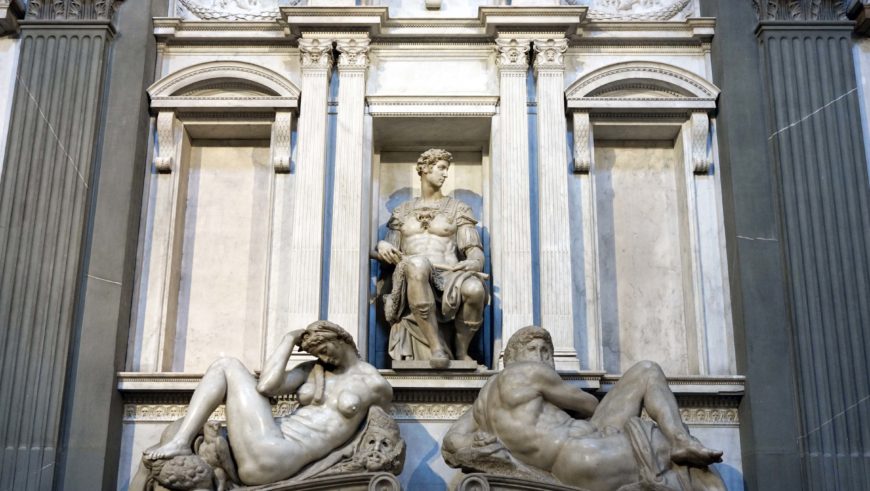
Michelangelo, Tomb of Giuliano de’ Medici, 1526-33, marble, 630 x 420 cm (New Sacristy, San Lorenzo, Florence) (photo: Steven Zucker, CC BY-NC-SA 2.0)
In 1527, during a period of political turmoil, the Florentine Republic took back control from the Medici. Two years later, the city came under siege by troops of Holy Roman Empire and the Medici were reinstalled. Despite his longtime connections to the family, Michelangelo, a republican at heart, left Florence forever in 1534.
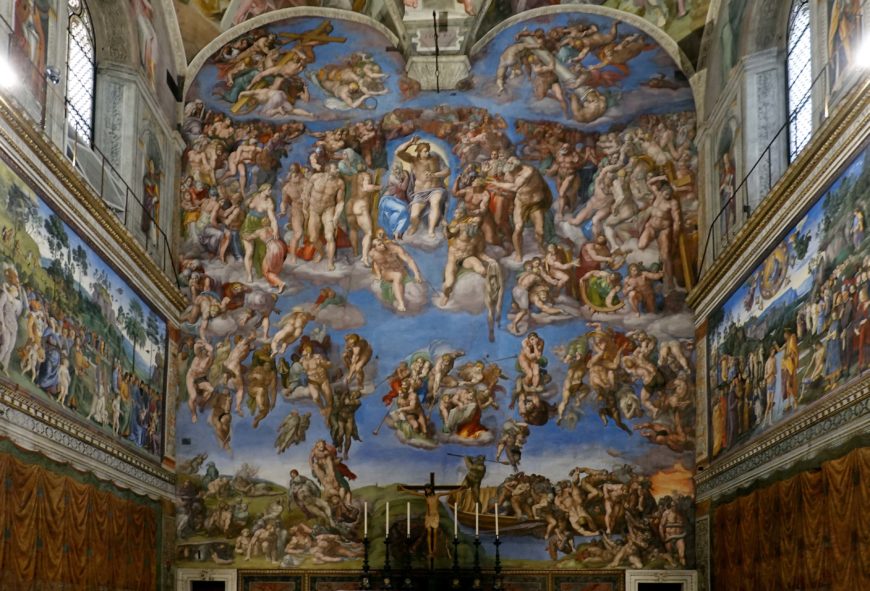
Michelangelo, Last Judgment, Sistine Chapel, altar wall, fresco, 1534–1541 (Vatican City, Rome) (photo: Richard Mortel, CC BY 2.0)
Late life in the Eternal City
Michelangelo’s second fresco in the Sistine Chapel in Rome, the Last Judgment, was commissioned by Pope Paul III and was painted between 1535 and 1541. It also functioned as a study tool for artists. Giorgio Vasari, the sixteenth-century artist and biographer, claimed that artists no longer needed to study live models from nature since every conceivable human position was represented in Michelangelo’s fresco. To accomplish this, Michelangelo positioned tiny wax models to help develop the complex, large-scale composition. Reliance on Michelangelo’s contorted figures by later artists resulted in a sense of artificiality, a prized characteristic of Mannerism. The artist was constantly developing new working practices. For example, in order to extend working hours, Michelangelo made a headlamp with a special wax candle so he could paint into the late hours of the night, often forgetting to eat. Long days proved dangerous though, and he took a bad fall off the scaffolding, nearly breaking his leg.
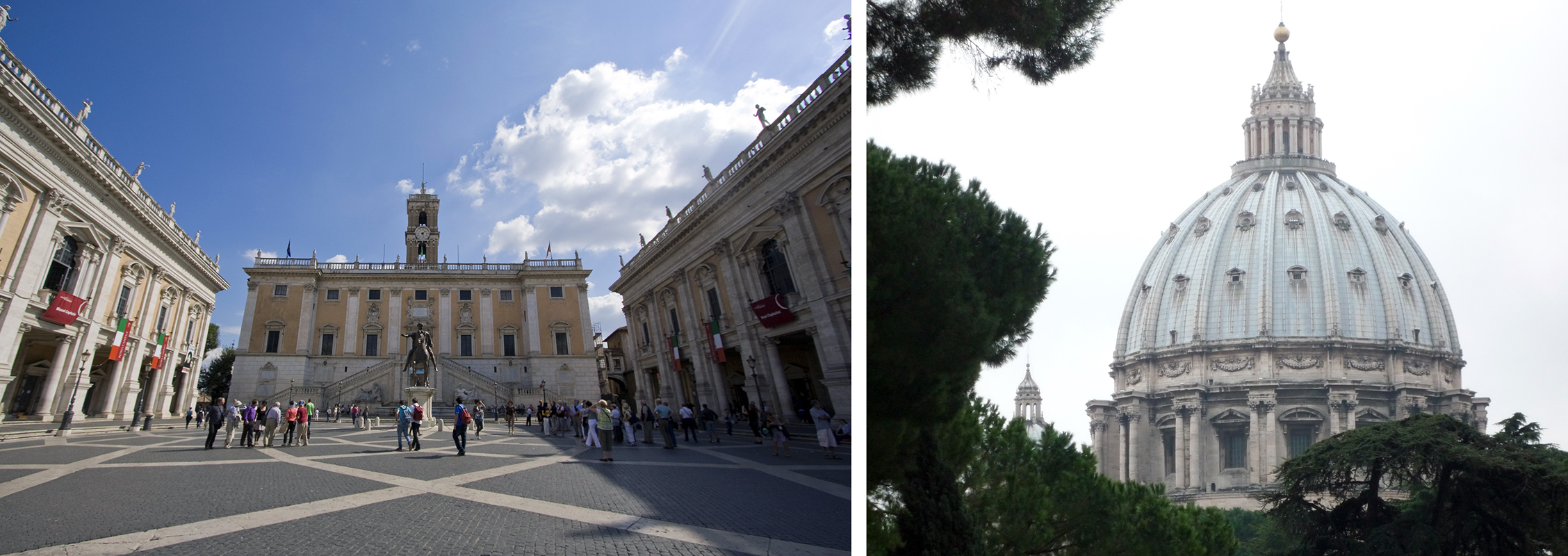
Left: Michelangelo, Piazza and palazzi of the Capitoline Hill, Rome, 1536–1546 (photo: Lawrence OP, CC BY-NC-ND 2.0); Right: Michelangelo, Dome of St. Peter’s Basilica, Vatican City, Rome, 1546–1564 (photo: Steven Zucker, CC BY-NC-SA 2.0)
Michelangelo became a Roman citizen in 1537, and it was here that he established his legacy as an architect. During the last two decades of his long life, Michelangelo focused on architectural commissions, sculpting only for himself. His major projects included renovating the Capitoline Hill and overseeing the construction of St. Peter’s (without pay for not only the salvation of his soul but also to retain complete creative control). As a devout Christian, Michelangelo made pilgrimage to all of Rome’s seven martyr churches during his old age. As he aged, he became more and more stubborn, riding his horse in the rain, for example. Owning horses was seen as an aristocratic endeavor, a status the artist became increasingly concerned with over the years. In his 1553 biography by Ascanio Condivi written with the artist’s consultation, Michelangelo emphasized his family’s nobility as a descendent of the counts of Canossa.

Michelangelo, Pietà for Vittoria Colonna, c. 1538–44, black chalk on paper, 28.9 x 18.9 cm (Isabella Stewart Gardner Museum, Boston)
The artist never had children (he claimed his artworks were his children), or even proper students. Instead, he sought to groom his nephew Lionardo as the sole Buonarotti heir. Michelangelo also established many great friendships such as that with Vittoria Colonna, whom he gifted a devotional Pietà drawing. He turned to this theme for his own tomb memorial, now known as the Florentine Pietà. Michelangelo attempted to carve four figures out of one marble block, a nearly impossible task. This act was in direct competition with the famed ancient Laocoön, which, despite legend, was discovered by the artist to have been made of several pieces of stone. Here, Mary holds the dead Christ with Mary Magdalene on the left and Nicodemus behind them, figures who each witnessed the death of Christ. Michelangelo carved his self-portrait in the face of Nicodemus, placing himself over Christ in a last wish for salvation. In the end, this image did not adorn his tomb. However, he continued to carve almost daily up until his death in 1564; an onlooker described the eighty-something year old’s blows with a hammer as incredible.
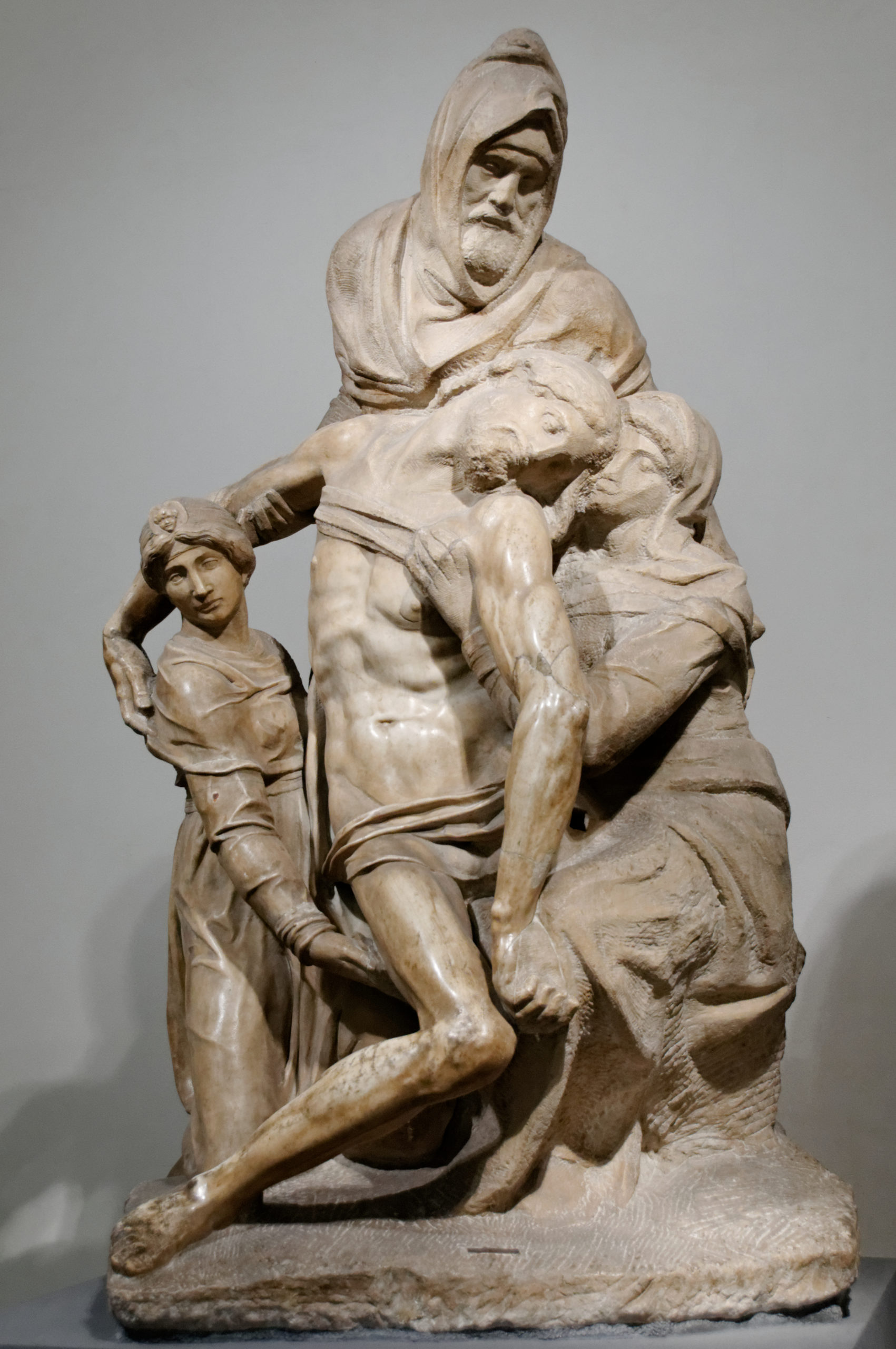
Michelangelo, Deposition (The Florentine Pietà), c. 1547–55, marble, 2.26 m high (Museo dell’Opera del Duomo, Florence, photo: Marie-Lan Nguyen, CC-BY 2.5)
The Florentine Art Academy, founded under the leadership of Vasari a year before Michelangelo died, erected the largest funerary memorial for an artist to date, naming him the father of the arts. Artists throughout the ages—from Caravaggio to Bernini, to Reynolds to Rodin, to Picasso to Hockney—looked to the art of Michelangelo as the founder of a forceful, new figural style. Michelangelo elevated the status of the artist more than any other artist of his time. He valued artistic freedom and personal expression, making art his way. Only with this in mind, can his creative vision and legend truly be appreciated.
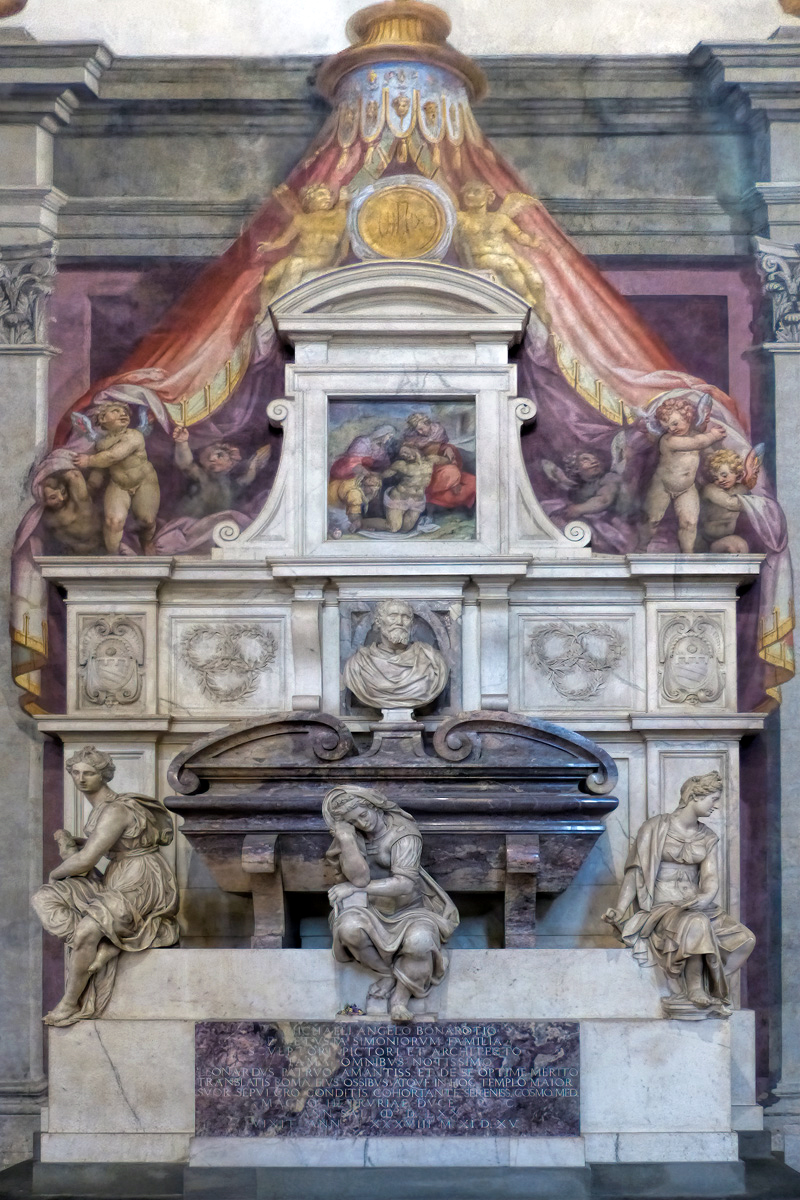
Michelangelo’s tomb, Basilica of Santa Croce, Florence (photo: Walwyn, CC BY-NC 2.0)
Notes:
- Giorgio Vasari, Lives of the Most Eminent Painters, Sculptors and Architects, vol. IX, translated by Gaston du C. de Vere (New York: Alfred A. Knopf, 1912, p. 4–5).
- Ibid, p. 25.
- James Saslow, trans. The Poetry of Michelangelo (New Haven: Yale University Press, 1991), p. 70.
Additional resources:
Vasari’s Lives of the Most Eminent Painters, Sculptors and Architects in English translation at Project Gutenberg
Second edition of Vasari’s Lives of the Most Eminent Painters, Sculptors and Architects in Italian at Archive.org
Virtual tour of the Sistine Chapel
Michelangelo’s design for the Tomb of Pope Julius II della Rovere at the Metropolitan Museum of Art
See more pictures of the Medici Chapel (New Sacristy)
James Ackerman, The Architecture of Michelangelo (Chicago: University Chicago Press, 1986)
Francis Ames-Lewis and Paul Joannides, eds. Reactions to the Master: Michelangelo’s Effect on Art and Artists in the Sixteenth Century (Aldershot, England: Ashgate Publishing, 2003)
Umberto Baldini and Perugi Liberto, The Complete Sculpture of Michelangelo (London. Thames and Hudson, 1982)
Carmen C Bambach, et. al, eds., Michelangelo: Divine Draftsman & Designer (New York: The Metropolitan Museum of Art, 2017)
Leonard Barkan, Michelangelo: A Life on Paper (Princeton: Princeton University Press, 2011)
Bernadine Barnes, Michelangelo and the Viewer in his Time (London: Reaction Books, 2017)
Paul Barolsky, Michelangelo’s Nose: A Myth and its Maker (University Park: Pennsylvania State University Press, 1997)
______, The Faun in the Garden: Michelangelo and the Poetic Origins of Italian Renaissance Art (University Park: Pennsylvania State University Press, 1994)
Anscanio Condivi, The Life of Michelangelo. Edited by Hellmut Wohl. Translated by Alice Sedgwick Wohl. 2nd ed. (University Park: Pennsylvania State University Press, 1999)
Robert J. Clements, Michelangelo: A Self-Portrait (New York: New York University Press, 1968)
Charles De Tolnay, Michelangelo: Sculptor, Painter, Architect (Princeton: Princeton University Press, 1975)
Rona Goffen. Renaissance Rivals: Michelangelo, Leonardo, Raphael, Titian (New Haven: Yale University Press, 2004)
Marcia B. Hall, ed. Michelangelo’s ‘Last Judgment’ (Cambridge: Cambridge University Press, 2004).
Howard Hibbard, Michelangelo. 2nd ed. (New York: Harper and Row, 1974)
Deborah Parker, Michelangelo and the Art of Letter Writing (New York: Cambridge University Press, 2014)
Lisa Pon, “Michelangelo’s Lives: Sixteenth-Century Books by Vasari, Condivi, and Others.” The Sixteenth Century Journal 27 (1997): 1015–1037.
Pina Ragionieri and Gary M. Radke, Michelangelo: The Man and the Myth, exhibition catalogue. Translated by Christian and Silvia DuPont (Syracuse, NY: University of Pennsylvania Press, 2008)
James M. Saslow, The Poetry of Michelangelo: An Annotated Translation (New Haven: Yale University Press, 1991)
Tamara Smithers, ed., Michelangelo in the New Millennium (Boston: Brill, 2016)
______, The Cults of Raphael and Michelangelo: Artistic Sainthood and Memorials as a Second Life (New York and London: Routledge, 2023)
David Summers, Michelangelo and the Language of Art (Princeton: Princeton University Press, 1981)
Giorgio Vasari, Lives of the Most Eminent Painters, Sculptors, and Architects. 10 vols. Translated by Gaston du C. De Vere (New York: Alfred A. Knopf, 1912)
______, Lives of the Artists. 2. vols. Translated by George Bull (London: Penguin, 1965)
William E. Wallace, Michelangelo, God’s Architect: The Story of his Final Years and Greatest Masterpiece. Princeton: Princeton University, 2019.
______, Michelangelo: The Artist, the Man and His Times (Cambridge: Cambridge University Press, 2010)
______, Michelangelo: The Complete Sculpture, Painting, Architecture (New York: Universe, 2009)
______, ed. Michelangelo, Selected Scholarship in English: Life and Early Works. 5 vols. (New York: Garland Publishing, 1995)

